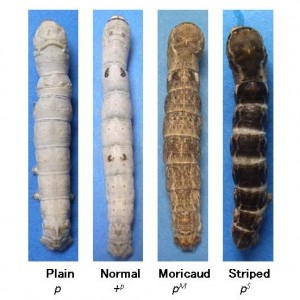Mechanisms producing diverse coloration patterns in caterpillars Single novel gene apontic-like controls patterns

It is known that eye spots on the larvae of butterflies and moths (caterpillars) function as aposematic (warning) signals to predators, and that the complex brown patterns on larvae of the ancestral strain of the silkworm camouflage larvae to dead branches. It has also long been known that in the silkworm, Bombyx mori, the genes for 15 different larval pigmentation mutants are known to be mapped to a single location on the chromosome, the p locus. It was thought that this unknown gene at the p locus was producing this variety of patterns, but its mechanism was unknown.

© 2014 Haruhiko Fujiwara.
Four different mutants of the p allele of silkworm.
The silkworm on the left has no markings at all. In contrast, a characteristic pattern of colored eye spots can be seen on the body segments of the next silkworm. The dark pattern of the third larva resembles that of the wild silkmoth, Bombyx mandarina. Bold black stripes can be observed on each body segment. In addition to these, 11 different mutants with different patterns are known.
Now, a research group including Professor Haruhiko Fujiwara and doctoral student Mr. Shinichi Yoda at the Graduate School of Frontier Sciences, the University of Tokyo, used silkworm mutants to elucidate the mechanism by which a single gene regulates the diverse coloration of caterpillars. Using various molecular biological techniques, the responsible gene for the p locus was determined to be a novel transcription factor gene which the researchers have named apontic-like. The group showed that varied marking patterns on the silkworm larva were produced by altered expression of the gene on the larval epidermis. In addition, it is possible that apontic-like is also involved in the coloration of other caterpillars, such as swallowtail larva.
The current results are an important finding regarding the mechanisms behind divergent evolution, where a single ancestor gives rise to a diverse group of organisms, and convergent evolution, where genetically diverse organisms evolve to have similar forms. It also shows that research into patterns of caterpillar coloration is an excellent model that could have great impact on the fields of evolutionary biology and ecology.
These findings have been published in the online edition of the journal Nature Communications (Sep 18, 2014).
Press release (Japanese)
Paper
Shinichi Yoda, Junichi Yamaguchi, Kazuei Mita, Kimiko Yamamoto, Yutaka Banno, Toshiya Ando, Takaaki Daimon & Haruhiko Fujiwara,
“The transcription factor Apontic-like controls diverse coloration pattern in caterpillars”,
Nature Communications 5 (4936) Online Edition: 2014/9/18 (Japan time), doi: 10.1038/ncomms5936.
Article link
Links
Graduate School of Frontier Sciences
Department of Integrated Biosciences, Graduate School of Frontier Sciences






